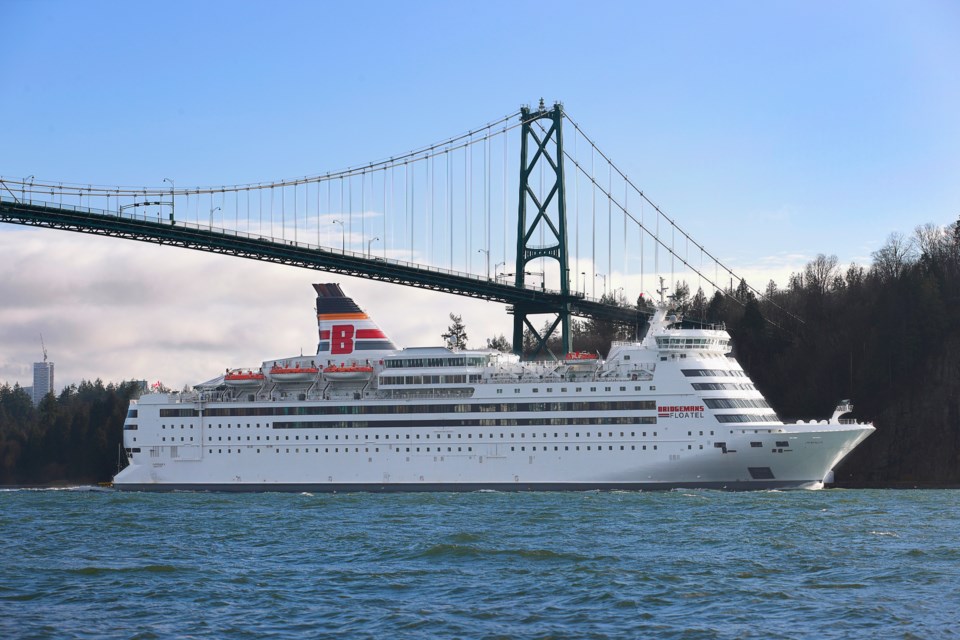The Woodfibre LNG Project, located in Nexwnéwu7ts Átlḵ’a7tsem (Howe Sound) on the historical site of Swiy̓át, a Sḵwx̱wú7mesh Úxwumixw (Squamish Nation) village, is pioneering the world’s first net zero LNG export facility. The completed facility will be powered by renewable hydroelectricity, along with the use of other best-in-class technologies, which will result in a facility with a carbon intensity four times less than the provincial benchmark for carbon intensity for LNG projects and about nine times less than the global average. Site preparation and early construction works are currently underway at the Woodfibre LNG site.
An innovative approach is also being taken to housing non-local workers during the construction phase of the Project through the use of a floatel. Expected to arrive in spring 2024 and remain moored until project completion in 2027, the floatel will house approximately 650 non-local workers during construction, supporting the Woodfibre LNG Project's goal of sustainable development.
What is a floatel?
Floatels are increasingly used for worker accommodation, especially when land-based options pose significant challenges. Floatels offer swift deployment and removal, along with sustainable operation, leaving no ecological footprint upon departure. The Woodfibre LNG floatel is a modern vessel with state-of-the-art sewage, water and power services that meet or exceed Canadian and provincial regulations. A converted cruise ship, the floatel offers a premium live-work environment for its residents, including:
- Individual rooms with private ensuites
- Catered dining areas
- Outdoor and sports lounge
- 8,000 square foot fitness facility
- Billiards and games room
Why is a floatel being used on the Woodfibre LNG Project?
In 2019, Woodfibre LNG began the process of gathering input from the community about the potential impact of the construction project and development of an LNG facility. The company received thousands of comments, many registering concerns about traditional work camps, the potential influx of non-local workers and the potential impact on rental housing, traffic and the safety of women and girls.
Woodfibre LNG listened, heard, and responded with a community-driven solution in the form of a floatel.
How does a floatel address concerns expressed by the community?
From the start, the priority for Woodfibre LNG has been to ensure the construction of the Woodfibre LNG facility has as little impact on the Squamish community as possible—and the floatel system helps do just that.
Woodfibre LNG received an amendment to its environmental assessment certificate to authorize the floatel, and conditions that restrict community access and travel into the community for non-local workers.
Accommodating workers on the floatel, while maintaining strict restrictions on community access, ensures that workers do not impact community infrastructure and services. At the same time, it provides them with world-class, safe, and comfortable living accommodations.
The use of a floatel is also supported by a coalition of hereditary chiefs and the project’s Gender Safety Committee Advisory Committee as it will also address other concerns that are sometimes associated with work camps, ensuring a safe working environment for all workers, including Indigenous women.
When are workers expected to occupy the floatel?
The provincial government and Squamish First Nation formally approved the floatel several months ago. The floatel is now awaiting approval by the District of Squamish. Workers are anticipated to occupy the floatel in spring 2024.
What is the cost of the floatel and who is footing the bill?
Woodfibre LNG pays the full cost of the $100 million floatel and the cost of catering, housekeeping, and other services on board, as part of its commitment to ensure the project has as little impact on Squamish as possible.
How will gender safety be addressed on the floatel?
To work on the project, all workers must sign a code of conduct which includes gender safety provisions. They are also required to take a half-day, in-person cultural awareness and gender safety training session delivered by Squamish Nation trainers.
To further support a welcoming and respectful workplace culture, Indigenous Floatel Cultural Managers will be on board the vessel. A first-of-its-kind Gender and Cultural Safety Management Plan is a provincial regulatory requirement on the project and will further the zero tolerance policy for, and provide safe and appropriate mechanisms for preventing and responding to, any form of bullying, harassment or sexualized violence.
In addition, 24-hour safety and security measures are in place, including security badging stations and onboard security, to ensure the comfort and safety of all workers.
How will workers be transported to and from the floatel?
To ensure no impacts on traffic through Squamish, non-local workers will be transported by boat from the Lower Mainland to and from the floatel at the Woodfibre LNG project site.
What is the environmental impact of the floatel?
The floatel is designed to have net zero environmental impact. It will operate on hydroelectric shore power and has a wide array of advanced environmental systems, including a water treatment system, industrial heat pumps and sewage treatment that includes ultrafiltration, a low intensity UV unit and shipping to a waste management facility in B.C. The floatel is designed to eliminate waste and recycle as much as possible.



